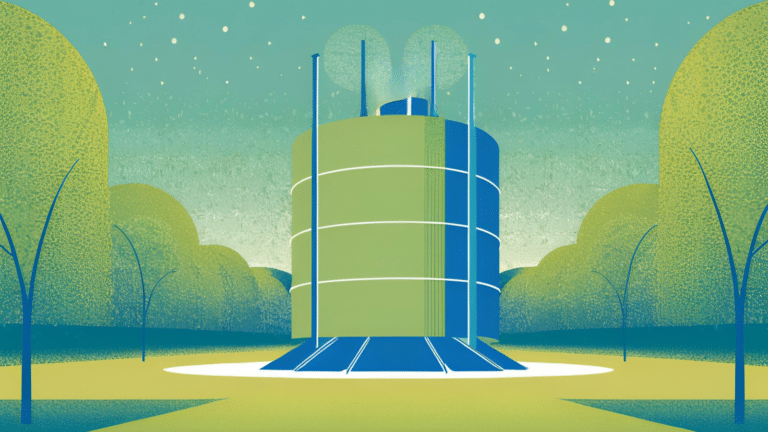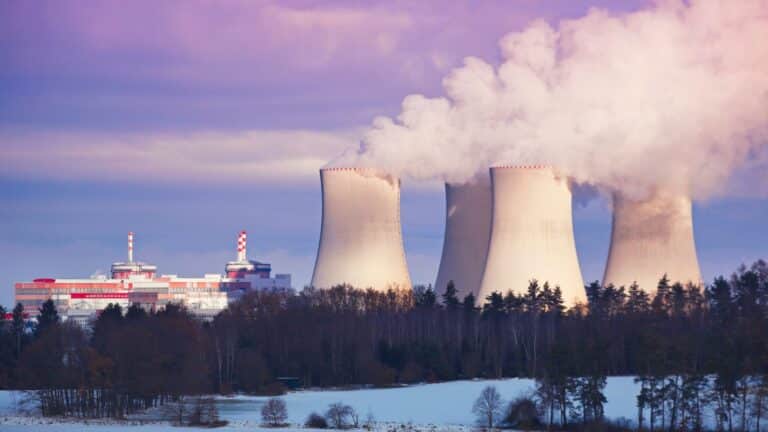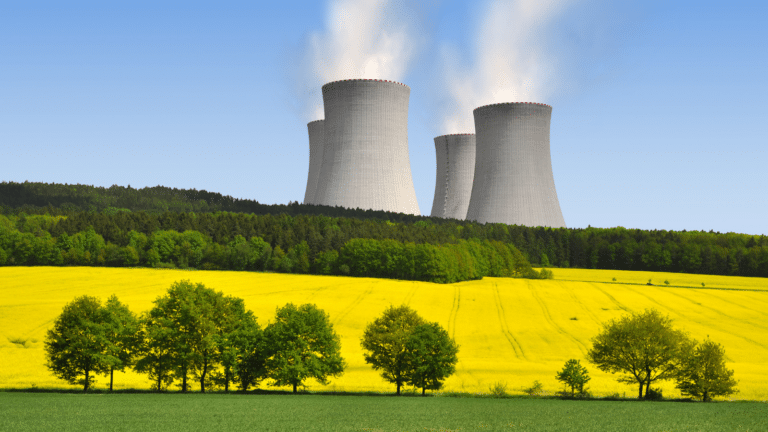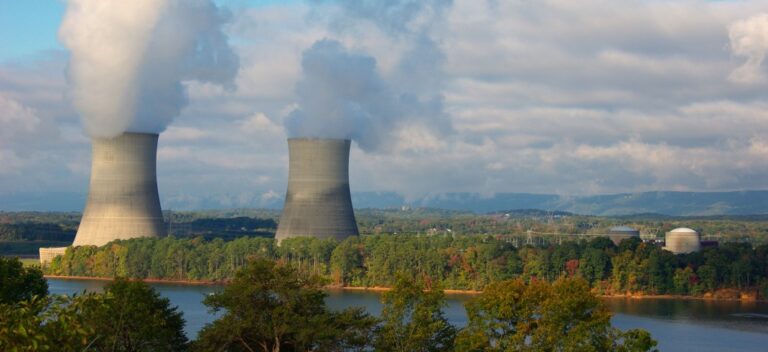China Halts U.S. LNG Imports Amid Tariff War
China has ceased importing liquefied natural gas from the United States since early February, as the ongoing tariff war impacts energy trade.
Current Access Level “I” – ID Only: CUID holders, alumni, and approved guests only
Jonathan Hinze [00:00:03] Prior to the war, we were in somewhat of a balanced market. But if you remove that pretty big chunk of Russian supply, especially quickly, there’s just not capacity to make up for that. The lead times are long, but the supply chain lead times are even longer. To build a new enrichment plant or a new conversion plant takes years. Maybe by the end of this decade, the West could fully supplant the supply that Russia has today in the market. But in the next two or three years, it would probably be impossible to create that supply chain.
Bill Loveless [00:00:38] Western countries are once again trying to reduce their reliance on Russian resources. This time it’s nuclear fuel. Russia accounts for a substantial share of both conversion and enrichment services worldwide. The two processes that turn uranium into usable fuel. The war in Ukraine has raised concerns about supply disruptions like shipping and payment and government actions that could ban imports. But severing ties with Russia’s nuclear industry is difficult. Attempts at Western sanctions have faltered because of limited domestic capabilities in the US and Europe. For that reason, Russia’s nuclear fuel industry has been largely immune from sanctions imposed by Western nations over Moscow’s invasion of Ukraine. But that may change as the war continues and the U.S., Europe and other nations weigh options to make them less dependent on Russia to maintain and expand their nuclear power plant fleets. So what are the alternatives to Russian services and how will it impact the stability of the global nuclear fuel market? This is Columbia Energy Exchange, a weekly podcast from Columbia University’s Center on Global Energy Policy. I’m Bill Loveless. Today on the show, Jonathan Hinze and Bill Freebairn. Jonathan is the president of USC LLC, a market research and analysis company covering the nuclear industry. He has nearly two decades of experience working in the U.S. and Japan on technology development, international markets and government policies. Two of his main areas of focus are nuclear fuel markets and reactor supply chains. Bill is a senior managing editor for S&P Global Commodity Insights, where he writes about nuclear plant operations, new nuclear plant construction, regulatory developments, financial issues and uranium markets. He leads the Nuclear Onyx Week publication, which is a source of global news for the commercial nuclear power business. I talked with Jonathan and Bill about how Russia came to dominate global nuclear fuel production and why it’s so difficult for other countries to find alternative supplies. We discussed why supply and demand are so tight and how it will shape the global market for the rest of the year. Here’s our conversation. Jonathan Hinze, Bill Freebairn, welcome to Columbia Energy Exchange.
Jonathan Hinze [00:03:15] Thank you. Good to be here.
Bill Freebairn [00:03:17] Thanks, Bill.
Bill Loveless [00:03:18] Well, Jonathan, it’s it’s good to meet you, so to speak. I’ve become that much more aware of your work in recent days as I prepared for the conversation we’re having today and look forward to it. And Bill, of course, Bill Freebairn and I are all colleagues from Platts, part of S&P Global. We worked cheek by jowl in the newsroom at 12th and G in downtown D.C. for a number of years. And I always enjoyed those times, those conversations we had back in those days, Bill.
Bill Freebairn [00:03:49] Yeah, great. Great to talk to you again, Bill.
Bill Loveless [00:03:52] Well, you know, this is a big topic right now, and perhaps with all this going on with the war in Ukraine and energy, it may be the topic that’s gotten perhaps a whole lot less conversation than some other energy commodities like oil and natural gas. But, you know, Russia’s nuclear industry has gone largely unscathed over the past year, even as the U.S. and Europe imposed heavy sanctions on Russia’s energy sector as punishment for Russia’s war on Ukraine. Jonathan, why has that been so?
Bill Freebairn [00:04:24] Yeah, so it’s it’s obviously a complicated issue when it comes to nuclear power and nuclear exports from Russia. I think, you know, it’s it’s important to appreciate just how big of a role Russia played prior to the war, mainly when it comes in the West to the fuel supply, because so much of the world is still dependent on Russian nuclear fuel for the commercial nuclear industry, whether it’s in Europe, which can be upwards of 30% in in the east and west combined of Europe and maybe up to 20 to 25% in the U.S. right now. So we just are in a situation where sanctioning Russia over nuclear fuel supplies might be actually more detrimental to our own situation, i.e., you know, we’d have huge increases in costs and potentially even supply shortfalls if we got rid of Russia overnight. And that’s that’s really what’s driving the current situation.
Bill Loveless [00:05:34] You know, I think one thing to be helpful to everyone listening to be here today is to make sure we’re all understanding the fuel cycle here for for a nuclear civilian nuclear power. Bill, can you explain briefly the fuel that’s used in nuclear reactors and and how it’s made?
Bill Freebairn [00:05:55] And this is this is a very it’s a very complex supply chain. It’s a very lengthy period. You know, people think, well, coal, you know, you dig it up, you throw it in the in the boiler and you have electricity for nuclear energy. You know, you’re digging up uranium and it’s a year or a year and a half before that uranium can actually be used in a reactor. And it has to go through a variety of transformations. It has to be processed to form a concentrate that’s dug out of the ground, converted into a gas form, and then it’s enriched so that it has the proper amount of fissile material to to create a fission reaction in a reactor. You’ve got to then convert it back into a powder, sinter it into a pellet, and stack those inside of a little zirconium tube, which is then fabricated into a fuel assembly. So as you can imagine, that takes a lot of time. And that means that the timescales that we talk about in nuclear energy are always way longer than people might associate with commodities. And it’s various stages of this process where Russia has a lot of control. And a lot of market share. And it’s a complex issue because some countries depend have dependent exclusively on Russia to provide the finished fuel assemblies, whereas other countries only rely on it to provide enriched uranium, which they then turn into fuel. And so it’s a it’s a series of relationships, contracts and delivery patterns across the world in what is a really varied global industry historically, as Jonathan points out. Russia has been a big player in this industry, has a dominant role, has been a low price provider and basically supplies, you know, people all around the world with different stages of the finished nuclear fuel product.
Bill Loveless [00:07:43] Yeah. Jonathan, just to follow up on Bill’s comment and one you made earlier. Can you sort of flesh out for us the extent to which Russia contributes to this global fuel supply for for nuclear power plants in these various stages? How significant is it?
Bill Freebairn [00:08:00] Yeah, I mean, it depends on the stage. So as Bill correctly pointed out, it’s not just one supply that we’re looking at. We’re looking at the different stages in the fuel cycle, as we call it. And, you know, probably the most dominant part of that fuel cycle that Russia has is in what we call the enrichment step. So that’s when the the U-235 isotope gets increased from its natural level. And that’s mainly a result of Russia’s very large Cold War military program, where they built up a very large enrichment industry, mainly dedicated that that time to build building nuclear weapons. But after the Cold War ended, you know, that capacity was transitioned to a commercial role. And so, you know, Russia basically has four huge facilities around the country where they conduct this enrichment, and it represents somewhere around 40% of the world’s capacity. And comparing that to the West, we basically have two other suppliers in the world that do that. One company called Your Renko, which is a multinational European company with operations in Germany, Netherlands, UK and the U.S. and another company, Orono, which is a French company with operations in France. So those are the two other competitors. But again, combined, Russia has somewhere around 40% of that capacity. And then in other stages, whether it’s the uranium hexafluoride production, which is an intermediate step called conversion, they’re a big player there. The only place where Russia doesn’t have much of a role is in natural uranium production. That’s the mining step. It actually relies a lot on imports itself from places like Kazakhstan. And then the last step, which is more unique to each reactor design, that’s called fabrication, where, as Bill noted, you put together the fuel assemblies. Those really are specific to each type of reactor. And Russia builds a certain kind of reactor that we call VTR. And those of ours use a type of fuel assembly that until recently was never produced anywhere in the West. And only in the last couple of decade or so, a Westinghouse company in the U.S., but with operations also in Sweden, has been, you know, entering that market, but still on a smaller scale. So Russia really has dominated that Russian VTR fuel assembly step.
Bill Loveless [00:10:52] Yeah. And Bill, in addition to supplying fuel, Russia provides parts and other support for nuclear reactors in other countries that were built based on Russian designs like this VVA VR design that Jonathan just mentioned. And there are more Russian designed plants underway in other countries, even as we speak. Right?
Bill Freebairn [00:11:13] Right. Yeah. No, we’re we’re you know, Russia was up until a couple of years ago, they were the most successful exporter of nuclear plants around the world. And so even today, you know, they have just recently built plants in Belarus. There plants under construction in Bangladesh. They just started construction in Egypt on some plants that they’re supplying. And Hungary is going to turn on the first unit of its Russian supplied nuclear plant, the first of its of that country’s either around the end of this year or maybe next year. So they’ve been very successful sending their technology overseas. Now this this this this war, this invasion is really executives are telling us that this represents perhaps a sea change in some aspects of Russia’s ability to supply the world with nuclear energy and services and fuel. And I think the one of the key cases is actually the case of Ukraine. Here’s a country that had already fought a war with Russia in the past, but had been entirely reliant on Russia, too, for supplies of nuclear fuel because they operated these Soviet designed plants. And they’re highly dependent on nuclear power in Ukraine. But when they saw their conflict with Russia begins years ago and they began the difficult process of weaning themselves from 100% supplier of their nuclear fuel and and related services. And they really blazed a trail which brought in a US vendor, Westinghouse, in a Swedish facility, began to fabricate fuel that could be used inside of a Russian Soviet designed reactor. And this was a difficult process that involved a lot of regulatory steps. There had to be a lot of testing, and over the years they proved that you could do this. And they’ve blazed a commercial trail in which they just recently announced that they’re no longer going to rely at all on Russia for nuclear fuel. And all the countries in Eastern Europe that operate these Russian reactors are going to try and slipstream behind Ukraine and switch, I think, to vendors. And executives are telling us that this is perhaps dramatic and they believe maybe permanent realignment in how nuclear fuel is supplied, especially in these Eastern European countries.
Bill Loveless [00:13:30] Jonathan, it’s interesting to hear Bill describe that sort of transition that’s occurring. I was struck by a headline in Bloomberg News this week that said, quote, Russia’s grip on nuclear power trade is only getting stronger. That was the headline. This story went on to cite new data showing nuclear exports had surged since the invasion of Ukraine and boosting the Kremlin’s revenue and cementing its influence over a new generation of global buyers. As the U.S. and its allies shy away from sanctioning the industry. That’s again, from a Bloomberg story this week. I mean, that that was rather a stark assessment of the market, I thought.
Bill Freebairn [00:14:13] Yeah. So a couple of detail points there that may be lost in the story is one, is Russia, as we talked about earlier, hasn’t yet been sanctioned to much of a degree in terms of the fuel it supplies and the, you know, the reactors it’s selling to, as Bill said, places like Egypt and Turkey and Bangladesh, etc.. So those sales are continuing on the fuel side because of the war. Prices for the products that they’re selling have actually skyrocketed. There’s been a psychological factor already where, you know, the concern in the West, especially that Russia will be sanctioned, has driven the prices up. So Russia is actually selling its product now into a market which with much higher prices and is probably benefiting a bit from that. So when you look at the customs data, it does look like Russia’s exports have increased in the last year. I’m not sure volume wise they’ve increased, but obviously on a dollar value level they have increased. So that that’s a detail. Maybe that wasn’t completely clear in that story, but I did note that and I would generally agree that Russia has yet to be hit in many any significant way when it comes to nuclear exports. I mean, that’s one part of their economy that still is you know, I wouldn’t say completely free of of impact. But, you know, there’s been one project in Finland that. They were going to build a reactor in Finland that right after the war started. The Finns canceled that right away. You know, so that was an example of the impact. But, you know, for the most part, Russia’s nuclear exports are continuing unfazed.
Bill Freebairn [00:16:09] And everybody says it’s going to take time. You know, and that’s what we hear repeatedly from people in the industry, both in Europe and in the United States, is that it’s it’s such a long supply chain that it’s going to take a while to effectively disentangle the West from the Russian fuel supply. And even people who are sort of aggressively lobbying for bans on Russian uranium and fuel are generally incorporating some kind of a delay. Some kind of lag is that you can’t do it tomorrow, they’re telling us, because you shoot yourself in the foot. Right. The nightmare scenario for any operator of a nuclear plant is to not have the fuel that they need when they refuel these units refuel every 12 or 18 or 24 months. And they don’t require very regular refueling. But when they do, you know, they really want to have that fuel available. And the running the risk that a big nuclear plant might not be able to operate because it lacks fuel, that’s something that’s almost never happened in the history of nuclear energy. And the people in the industry are desperately trying to avoid that scenario.
Bill Loveless [00:17:15] And yet they’re you mentioned 12 to 18 months to refuel or to line up the refueling of a reactor. I mean, that’s a longer timeline than, say, European nations faced with trying to figure out how to replace Russian natural gas supplies or oil or refined oil products. I mean, they’re they’re they’re talking today or next week or next month. Right.
Bill Freebairn [00:17:38] I think there’s a general appreciation around the West and some places like Japan, South Korea, that, you know, reliance on Russia at the same level is not going to you know, we can’t continue to do business as usual. But, you know, while you could shut down a Nord Stream gas pipeline and maybe find LNG from Oman or somewhere to replace it, you’re not going to be able to do that in nuclear fuel. It’s just not the same kind of supply chain that we have. The the supply, especially when it comes to the conversion and enrichment steps, was already tight prior to the war. The enrichment, it’s a complicated thing. And so I don’t want to go too deep into the weeds here. But when you look at we had actually an excess of supply and enrichment, but now we are shifting. So uranium enrichment are a bit of a substitute for each other. So if you can use more uranium and less enrichment or vice versa. So right now they’re looking to use less enrichment in the West and more uranium upfront to make the same enriched fuel that the end product is. In any case, doing that, though, makes the other parts of the fuel cycle tighter as well. So prior to the war, we were in somewhat of a balanced market. But, you know, if you remove that pretty big chunk of Russian supply, especially quickly, you know, there’s just not capacity to make up for that. The same way maybe we had that in gas or oil. And, you know, yes, the lead times are long, but the supply chain lead times are even longer. To build a new enrichment plant or a new conversion plant takes years. We’re talking, you know, maybe by the end of this decade, the West could fully supplant the supply that Russia has today in the market. But in the next two or three years, it would probably be impossible to create that supply chain. So that’s the trick right now. It’s it’s a pretty big conundrum. But don’t get me wrong, I think everybody is expecting to move away from Russia as as Bill said, it’s it’s a realignment. The realignment just isn’t happening overnight.
Bill Loveless [00:20:06] Yeah. Ukraine’s president, Vladimir Zelensky, is continuing to press Western nations to sanction Russia’s nuclear sector. And there have been calls for sanctions in the European Union. But the EU hasn’t been able to secure the unanimous agreement of its member nations to take that step. Why is that? So, Bill.
Bill Freebairn [00:20:26] You know, the European Union’s an interesting organization, and organizationally, they require a lot of unanimity in some of these steps that they need to take. And of course, there’s always a few outliers. And in the case of nuclear fuel and sanctions on Russian nuclear companies, it’s Hungary, which has historic ties to the Russian Federation. And. Also has a current plan to build a new Russian source nuclear plant. And so as the only country in Eastern Europe currently outside of Belarus building Russian designed plants, it’s already made very clear it would not be in favor of any sanctions that could disrupt those plans. But, you know, as as Jonathan points out, this is a small industry in uranium enrichment and conversion that has very few companies involved. But governments across the Europe and North America are scrambling to to increase that capacity to possibly replace that Russian capacity. And we see in France right now a government plan to expand enrichment capacity. The U.S. government is looking desperately for four ways to supply enriched uranium and higher enriched uranium for U.S. companies. And the U.K. has already allocated money funding for a potential uranium conversion capacity to be added in the U.K.. So while it’s going to take a while, there is a lot of activity, there’s some allocation of funds already being done. And we do see the beginnings of this increase in capacity. It could one day, as Jonathan says, not any day soon, but one day could allow Western companies to replace Russian capacity. Although to be honest, when we talk to these companies, they are a little worried because this Russian capacity is still there and they worry very much that if there’s some kind of a solution to the Ukraine Russia problem, that that capacity could come back and render their massive investments kind of useless. And that that is a commercial concern that they all have, which is why the government role in this, we’re told, is going to be kind of critical.
Bill Loveless [00:22:44] Without unanimity in the EU or among EU nations. Is it impossible for the EU to impose these sorts of sanctions?
Bill Freebairn [00:22:54] Well, on an EU level it probably is just the way the rules are written. I’m not an EU policy expert so I can’t speak to the details, but my understanding is that some of the national governments are already quite aggressively pushing their companies to extract themselves from Russia, Sweden, Spain, you know, some of the countries that rely pretty heavily on nuclear. France is an interesting one. France is obviously the biggest nuclear market, getting around 70, 75% of its electricity from nuclear. So it’s a you know, it’s not just energy security there. It’s national security when it comes to the nuclear industry. And France has had a longstanding, very deep relationship with Russia. A little bit of history here, but going back to, I think 1972 was the first time that a Western company signed a contract to import enriched uranium from then Soviet Union at the height of the Cold War, and that was the French Electric Power company. So the French have obviously a strong history there. And, you know, they want to see diversified supply. And Russia has been a reliable supplier for going on 50 years now. So I think it’s going to be a some companies are self sanctioning, some governments are pushing. The UK has been very strong. It’s not part of the EU anymore. So they can do their thing. But, you know, long story short, I think with or without an EU sanction, you’re going to see the EU imports drop. Bill was talking about the fuel fabrication piece with the VR reactors in Eastern Europe. Ukraine obviously has already completely gotten rid of Russia, but other countries like Slovakia, Czech Republic, Bulgaria, Finland has some reactors that came from the Soviet Union. All of those are going to shift away from Russia. So I don’t know that a policy level, you know, sanction on the government level is what’s necessarily going to, you know, change the course on this. It’s going to be more individual companies and countries making that decision. When it comes to the EU, the US, I’d say, is a little different story.
Bill Loveless [00:25:18] Speaking of the U.S., Bill, your Washington based, what’s going on in the U.S. government?
Bill Freebairn [00:25:24] Well, there’s there’s there’s a lot of moving parts. And also it’s a very challenging political environment. So, you know, it’s it’s hard to see. There’s a there’s a variety of pieces of legislation that have some impact on this. There’s proposals floating around in the House to ban Russian imports after 2027. Effectively, there’s alternate legislation was just dropped by Senator Manchin and Senator Barrasso that relate to just providing funding, providing government funding and support for an assured supply of this low enriched uranium that fuels the country’s reactors. But there are significant questions about about whether those legislative vehicles can can can somehow pass in a very, very divided Congress, where you’re starting to see the political temperature ratcheted up. And we got a presidential election coming up in a couple of years. And so it’s going to be very interesting to see if any of that support, which has surprising bipartisan support. You know, nuclear energy has become an issue, a rare issue in Washington where, you know, Republicans and Democrats seem to agree more than disagree. But even so, the just the the the the rhetoric here in D.C. and the complications of our politics are such that it’s not clear if any of those bills can pass.
Bill Freebairn [00:26:47] I think it’s important to note that we already have a a quota system so the US can’t just import as much as we want from Russia. This quota has existed for several decades now and basically it limits the amount of enriched uranium that U.S. utilities can buy from Russia, a roughly around 20%. It was renegotiated in 2020, so that by later this decade that quota would drop to 15%. So us utilities, some don’t buy a single kilogram of enriched uranium from Russia. Others, you know, rely a little bit more heavily. But the overall total that the U.S. currently imports is roughly around 20%.
Bill Loveless [00:27:34] Jonathan, I just learned about that quota system. What gave rise to that?
Bill Freebairn [00:27:39] Oh, boy, that’s a history in itself. We could do a whole podcast on that. Yeah. I mean, it’s so it’s it’s relates to a trade case that was brought in the early 1990s against Russia when there was a basic an anti-dumping case and that was suspended at the time. And it’s been that case has continued to be suspended with the agreement. It’s basically an intergovernmental agreement between the U.S. and Russia. I’m simplifying this, of course, but basically it’s an agreement that signed by the U.S. Department of Commerce and the Rosatom, the Russian entity that manages their exports. That limits that number to around 20% of U.S. annual requirements is what is allowed to come into the country. So the Department of Commerce in the U.S. oversees that and make sure that those limits get applied.
Bill Loveless [00:28:39] Yeah. Bill, discussion of this quota system going back some some time. It reminds me that, you know, the U.S. and Russia previously the Soviet Union had somewhat of a history when it comes a unique history, when it comes to nuclear fuel. And and all I was I was reminded of a paper that two of the scholars, two of the scholars at the Center on Global Energy Policy, Matt Bowen, Paul Debar wrote last year. And among the milestones they noted was this 1993 agreement between the United States and Russia, nicknamed Megatons to Megawatts. That was a pretty big deal back in the day. Can you touch on that a bit?
Bill Freebairn [00:29:24] Yeah, You know, it was an agreement in which the U.S. and the then Soviet Union agreed to to take, you know, this, you know, surplus nuclear bomb material from Russia and convert it into fuel for for for nuclear plants. And in the United States, it provided a significant amount of the fuel used by reactors in the United States in that time period. And, you know, obviously, it’s a it’s a sign of how far we’ve come in that in that relationship that that that we’re we’re we’re we’re not talking about any kind of cooperation or collaboration right now that that these disputes have become very ingrained. And it’s it’s hard to see anything like that happening today, right?
Bill Loveless [00:30:05] Yeah. And there was a time when the United States had a rather dominant uranium enrichment industry here. Right, Jonathan?
Bill Freebairn [00:30:16] Yeah, Look, I mean, the U.S. Atomic Energy Commission, you know, from the Manhattan Project forward was the world’s number one and richer later, Soviet Union built their own technology to do it. But when the civilian nuclear industry began in the late sixties and seventies, the U.S. government was the number one or only supplier for some companies and utilities, not just in the U.S., but around the world. So that dominant position over time, you know, degraded. It was later privatized by the government. The only probably the biggest U.S. government privatization I can think of was that enrichment industry. It later became what is called U.S. Enrichment Corp USEC for short. But yeah, so these days, USEC is is has been transformed into a different company called Centers. And a little side note here centers is actually doesn’t have its own enrichment plant it all of those have been shut down the last one in Kentucky in 2014 I believe. In any case that’s a company center is now the biggest supply source. They have to sell enrichment in the West. Guess where it comes from? Russia. So they they are reselling Russian enrichment as well. So it’s it’s a big shift from where the U.S. used to be. And, yeah, there’s a lot of folks on both sides of the aisle that think that the U.S. really is in a very precarious position when it comes to its nuclear fuel supply. We rely on roughly 20% of our electricity on nuclear power. And, you know, when you look at it, we have a medium sized enrichment plant in new Mexico that’s run by this, your Inco, the European company. We have a medium sized conversion plant in Metropolis, Illinois, that’s operated by Honeywell. And that’s about it. We have almost no uranium mining at this time. There are mines that are probably going to restart in in various states. But, you know, at the moment, the U.S. is highly dependent on imports. And this is not something that was new when Russian tanks started to cross the border into Ukraine.
Bill Loveless [00:32:40] Well, there’s this other type of nuclear fuel that I read about lately. It’s critical for the development of advanced nuclear reactor technologies, a fuel supplied primarily by Russia. And it’s called high assay, low enriched uranium or hello. I think it’s how it’s pronounced. You can correct me if I have it wrong. Tell us about that situation and what the United States what steps the United States is taking to meet the fuel needs of those reactors Bill.
Bill Freebairn [00:33:13] Yeah, I pronounce that. Hey, Lou, there’s a little bit of a debate out there. You hear people saying it both ways. But it is it’s it’s it’s planned to be used by almost every company that’s developing one of these advanced reactors, which these are not cooled by water anymore. These are cooled by gas or sodium or some other form. And they’re viewed as potentially safer or more economic by their advocates. And they potentially are the next generation type of nuclear plant. And the United States government has funded to the tune of several billion dollars a couple of pilot programs that are going to be built perhaps by the end of the decade. And there’s a variety of vendors offering these types of units which tend to be smaller and modular. They might be able to be placed in different locations. They don’t rely on water, so they could be put in more arid areas. The advocates say they have a lot of benefits, but they do rely on this higher enrichment level. And because of regulatory, legal and other obstacles, there’s not this capacity to make this higher enriched fuel in the West right now. Russia is really the sole commercial supplier today. And so especially with two plants, these pilot plants plan to be coming online by the end of the decade. The US government and the industry are beginning to become very concerned that there you could build these plants, this new generation of technology and not actually have the fuel to turn them on. And that of course would be a tough situation for the industry and the government. So the government has gone out of its way to try and make this material available. There’s a couple of ways pathways to do that. You can down blend the sort of weapons grade, high enriched uranium to create the halo, which is up to 20% U-235. Or you can enrich uranium a little further than you would for a commercial plant, which usually uses. About a 5% enrichment level, but you need to make regulatory changes, new licenses and perhaps new capacity at the existing enrichment plants. And that requires an investment that the government is trying to spur. So they’re trying to do this. There’s a lot of money out there has been allocated for this. So there seems to be progress. But the time is running a little short, people say.
Bill Loveless [00:35:29] Jonathan, you mentioned centrists before and I’ve read where the centrists is, is says it’s close to starting up a 16 machine demonstration plant in Ohio for this sort of fuel.
Bill Freebairn [00:35:45] Yes. So that’s a demonstration program heavily funded by the U.S. government. And hopefully it works. I think, you know, we’ll find out by the end of this year or next year how that demonstration goes. There are also a number of other companies, your Renko, the big in richer, you know, and or I know the French company, they they are both also looking at this, either adding such capacity in New Mexico or in the U.K. or in France. And then there’s also a another potential technology called global laser enrichment. Geely, for short, is the company it uses an Australian developed laser enrichment technology called Silex. This company, Geely, is owned partially half by SY like systems out of Australia and Cameco, which is a big uranium mining and fuel services company in Canada. And so this deal could actually revolutionize the enrichment program if this laser technology takes off. The problem with all of these things is, you know, in nuclear, we talk about nuclear time, and nuclear time tends to be very long. And so, you know, we’re we’re talking about likely having some of these new technologies, whether it’s the centrist one or some of the other ones, you know, later this decade or by 2030 or so to supply this halo. The problem is, as Bill noted, the government is giving lots of money. I think in the infrastructure bill that passed in 2021, there was a three or $4 billion allocated to some of these advanced reactor programs. So they’re pushing for the advanced reactors to be built. They sort of missed the ball when it comes to the fuel. And so they’re now playing catch up. But that’s a long pole in the tent when it comes to, you know, getting those projects off the ground.
Bill Loveless [00:37:47] Well, before we go, I, I always like to ask reporters and analysts to give us a sense of what they’ll be watching most closely going forward. And of course, I asked that question without suggesting you reveal any any scoops or exclusives that you’re planning in the days ahead. But broadly speaking, Bill, you know what’s on your watch list these days?
Bill Freebairn [00:38:15] Yeah, Well, especially with regard to the supply of of nuclear fuel, I think we are watching the government action because a lot of things, as Jonathan points out, nuclear moves on a slower time scale. And it’s the most, you know, one of the most highly regulated activities on the planet. So government involvement is always critical. So we’re watching closely here in Washington whether a fuel program is stepped up here, whether the UK and France proceed in other countries with expanding the capacity for uranium conversion and enrichment as would be required. We’re watching in Eastern Europe how these countries announced their pivots away from Russia as a supplier. And of course, we you know, we want to know if there’s going to be any developments where an outright ban is is put in place. We haven’t talked about it, but there’s had been from the very start a concern that the Russians could actually cut off the West from nuclear fuel themselves proactively because they’ve done that with natural gas. So it’s not it’s not a strategy that’s completely off the table. And so we’re watching that as well. There’s no real indication that that’s going to happen. But, you know, we could wake up one day and see some challenges to this to this industry. And so it’s going to be interesting to watch, especially over the course of the next year when I think some key decisions are going to get made.
Bill Freebairn [00:39:40] Jonathan Yes, a good question. I guess two things I would highlight. One, we haven’t really talked about, but one of the most interesting ramifications of the war and the shifting nature of especially the natural gas market has been a real increase in interest in nuclear power. Again, I always point back to the fact that the. The last big boom in nuclear power was in the early seventies and it came out of the oil crises at the time. And so we’re seeing somewhat of a repeat of that now where the concern over fossil fuels, not just supply of, you know, fossil fuels, but also, of course, now with the increasing focus of climate change, finding alternatives. So nuclear really has gotten a big boost in some ways longer term, I think from the desire to, you know, both get away from fossil fuels and especially reliance on Russian gas, but also, you know, obviously to to clean up the environment. So that’s that’s a story that’s going to keep unfolding and obviously is very interesting. And I think the war has has had a big impact on that as well. And on the fuel side, I think, you know, we’ve talked about it at length already, but I think what’s going to be really interesting to watch in the next year or two is I think, as I said before, there’s there’s almost nobody in the market that thinks we won’t kick Russia out of the West. I think that’s it’s more a question of when, not if. At the same time, you know, that’s it’s a really tricky proposition to how do we thread that needle is going to be what’s what’s going to be on my radar the whole time I’m watching this. You know, we published the world prices for all these fuel components. And, you know, the markets have already reacted very strongly to these developments and the expectation that Russia gets kicked out. You know, I think it’s going to be key because the last thing we need, we need to make this make sure this gets done right, because the last thing we need is a situation where nuclear power, what I just talked about, the positive developments on nuclear power get hit when it comes to concerns over the fuel supply. So if you want nuclear power to succeed, which I think is a pretty important piece of the future, you know, climate change dealing with that, then you need to make sure that the fuel supply chain also continues to function as it as it has in the past. And even if we’re getting rid of Russia, we have to do that in a way that, you know, isn’t detrimental to the broader nuclear industry.
Bill Loveless [00:42:33] Well, this is it’s an interesting topic and one that we’ll continue to watch closely Jonathan. Bill, thank you for joining us today on Columbia Energy Exchange. As I say, when we have a conversation like this, I learned a lot. I hope others did as well. It’s been fabulous having you on the program today.
Bill Freebairn [00:42:54] My pleasure.
Bill Freebairn [00:42:55] Thanks, Bill. Thanks for having us.
Bill Loveless [00:43:01] That’s it for this week’s episode of Columbia Energy Exchange. Thank you again, Jonathan Hensley and Bill Freebairn, and thank you for listening. The show is brought to you by the Center on Global Energy Policy at Columbia University’s School of International and Public Affairs. The show is hosted by Jason Bordoff and May Bill Loveless. The show is produced by Stephen Lacy and Aaron Hartig from Post-Script Media. Additional support from Matt Bowen, Daniel Prop, Natalie Volk and Q Lee. Roy Campanella is the sound engineer. For more information about the podcast or the Center on Global Energy Policy, visit us online at Energy Policy, Columbia dot edu or follow us on social media at Columbia U. Energy. And you can read or review the show on Apple or Spotify. You can also let us know what you think by tweeting at us. And if you really like this episode, share it with a friend or a colleague. It helps us reach more listeners like yourself. We’ll see you next week.
Western countries are once again trying to reduce their reliance on Russian resources. This time it’s nuclear fuel.
Russia accounts for a substantial share of both conversion and enrichment services worldwide. These two processes turn uranium into usable fuel. The war in Ukraine has raised concerns about supply disruptions – like shipping and payment, and government actions that could ban fuel imports.
Still, the West has struggled to sever ties with Russia’s nuclear industry. Attempts at sanctions have faltered because of limited domestic capabilities to process uranium in the U.S and Europe. But as the war continues, the U.S., Europe and other nations are weighing options to make them less dependent on Russia’s nuclear industry.
So what are the alternatives to Russian conversion and enrichment services? How will changing supply chains impact the stability of the global nuclear fuel market?
This week host Bill Loveless talks with Jonathan Hinze and Bill Freebairn.
Jonathan is the president of UxC LLC, a market research and analysis company covering the nuclear industry. He has nearly two decades of experience working in the U.S. and Japan on technology development, international markets, and government policies.
Bill is a senior managing editor for S&P Global Commodity Insights, where he writes about nuclear plant construction and operation, regulatory developments, financial issues and uranium markets. He leads the Nucleonics Week publication, which is a source of global news for the commercial nuclear power business.
Both guests talk with Bill about how Russia came to dominate global nuclear fuel production and why it’s so difficult for other countries to find alternative supplies.
It’s hard to overstate how consequential President Trump’s “Liberation Day” tariffs have been for American economic policy. While the administration has paused the steep reciprocal tariffs it announced...

In energy policy circles, the word “resilience” often refers to future-proof systems or infrastructure designed for the transition away from fossil fuels. But resilience means something different to...

The European Union’s energy landscape is transforming rapidly, as the bloc works to reduce emissions, lower energy prices, and decrease dependence on Russian fuel—three goals proving to be...

Across America, energy policy is often driven by short-term politics over long-term planning. Despite record-breaking U.S. oil production in recent years, partisan battles continue over fossil fuels and...

This Energy Explained post represents the research and views of the author. It does not necessarily represent the views of the Center on Global Energy Policy. The piece...



